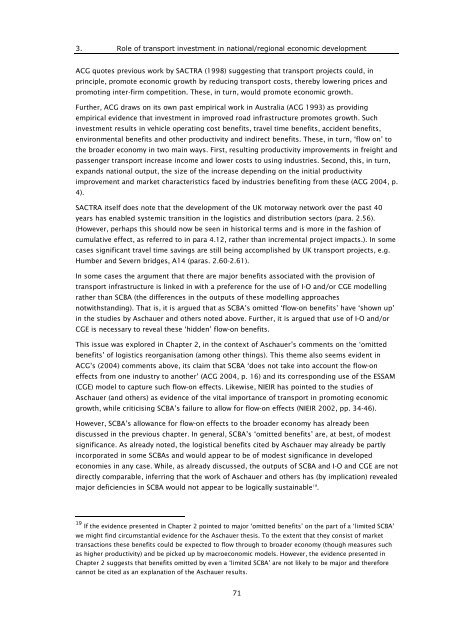Research 350 - NZ Transport Agency
Research 350 - NZ Transport Agency
Research 350 - NZ Transport Agency
You also want an ePaper? Increase the reach of your titles
YUMPU automatically turns print PDFs into web optimized ePapers that Google loves.
3. Role of transport investment in national/regional economic development<br />
ACG quotes previous work by SACTRA (1998) suggesting that transport projects could, in<br />
principle, promote economic growth by reducing transport costs, thereby lowering prices and<br />
promoting inter-firm competition. These, in turn, would promote economic growth.<br />
Further, ACG draws on its own past empirical work in Australia (ACG 1993) as providing<br />
empirical evidence that investment in improved road infrastructure promotes growth. Such<br />
investment results in vehicle operating cost benefits, travel time benefits, accident benefits,<br />
environmental benefits and other productivity and indirect benefits. These, in turn, ‘flow on’ to<br />
the broader economy in two main ways. First, resulting productivity improvements in freight and<br />
passenger transport increase income and lower costs to using industries. Second, this, in turn,<br />
expands national output, the size of the increase depending on the initial productivity<br />
improvement and market characteristics faced by industries benefiting from these (ACG 2004, p.<br />
4).<br />
SACTRA itself does note that the development of the UK motorway network over the past 40<br />
years has enabled systemic transition in the logistics and distribution sectors (para. 2.56).<br />
(However, perhaps this should now be seen in historical terms and is more in the fashion of<br />
cumulative effect, as referred to in para 4.12, rather than incremental project impacts.). In some<br />
cases significant travel time savings are still being accomplished by UK transport projects, e.g.<br />
Humber and Severn bridges, A14 (paras. 2.60-2.61).<br />
In some cases the argument that there are major benefits associated with the provision of<br />
transport infrastructure is linked in with a preference for the use of I-O and/or CGE modelling<br />
rather than SCBA (the differences in the outputs of these modelling approaches<br />
notwithstanding). That is, it is argued that as SCBA’s omitted ‘flow-on benefits’ have ‘shown up’<br />
in the studies by Aschauer and others noted above. Further, it is argued that use of I-O and/or<br />
CGE is necessary to reveal these ‘hidden’ flow-on benefits.<br />
This issue was explored in Chapter 2, in the context of Aschauer’s comments on the ‘omitted<br />
benefits’ of logistics reorganisation (among other things). This theme also seems evident in<br />
ACG’s (2004) comments above, its claim that SCBA ‘does not take into account the flow-on<br />
effects from one industry to another’ (ACG 2004, p. 16) and its corresponding use of the ESSAM<br />
(CGE) model to capture such flow-on effects. Likewise, NIEIR has pointed to the studies of<br />
Aschauer (and others) as evidence of the vital importance of transport in promoting economic<br />
growth, while criticising SCBA’s failure to allow for flow-on effects (NIEIR 2002, pp. 34-46).<br />
However, SCBA’s allowance for flow-on effects to the broader economy has already been<br />
discussed in the previous chapter. In general, SCBA’s ‘omitted benefits’ are, at best, of modest<br />
significance. As already noted, the logistical benefits cited by Aschauer may already be partly<br />
incorporated in some SCBAs and would appear to be of modest significance in developed<br />
economies in any case. While, as already discussed, the outputs of SCBA and I-O and CGE are not<br />
directly comparable, inferring that the work of Aschauer and others has (by implication) revealed<br />
major deficiencies in SCBA would not appear to be logically sustainable 19 .<br />
19 If the evidence presented in Chapter 2 pointed to major ‘omitted benefits’ on the part of a ‘limited SCBA’<br />
we might find circumstantial evidence for the Aschauer thesis. To the extent that they consist of market<br />
transactions these benefits could be expected to flow through to broader economy (though measures such<br />
as higher productivity) and be picked up by macroeconomic models. However, the evidence presented in<br />
Chapter 2 suggests that benefits omitted by even a ‘limited SCBA’ are not likely to be major and therefore<br />
cannot be cited as an explanation of the Aschauer results.<br />
71
















